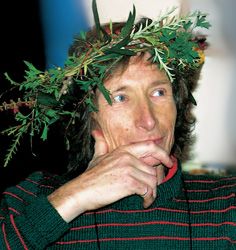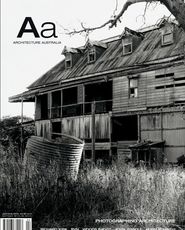TEACHER, CRITIC, HISTORIAN AND ARCHITECT, RORY SPENCE WILL BE GREATLY MISSED BY AUSTRALIA’S

Rory Spence on 16 May 2004, at his wedding to Sieglinde Karl, his partner of 32 years.
THERE ARE SOME individuals who everyone universally feels very privileged to know, and for me Rory Spence was very much one of those unique people.
He epitomized all that is worthwhile in a human being – both as gentle, caring person for all the people he met in the course of his daily activities; and also as an extremely perceptive, intelligent, thoughtful teacher and writer.
Coming from Newcastle, UK, from a family imbued with Quaker traditions and ideals, son of an architect and heir to an ongoing family tradition of civilized social commentary expressed through the arts, Rory grew up to become a spokesperson for these quiet but noble values in the New World.
He believed in improving people’s lives through intelligent considerate design, and he was always striving to find ways to create a more humane and civilized world. His teaching was intelligent and learned, and he was consistently positive yet honest in his criticism of students’ work, affirming rather than destructive of all their fledgling ideas.
With his partner Siegi Karl, he was closely involved in many aspects of the wider arts community. He loved the flora and fauna of his newfound home and became personally involved in ways to actively conserve and protect our environment.
He was one of very few whose unself-conscious humanity was always there, a source of immeasurable worth, always personally giving out to all those who came into contact with him – students, friends or casual acquaintances alike.
He will be greatly missed.
ROBERT MORRIS-NUNN
WITH THE DEATH OF RORY SPENCE in May this year, the architectural community lost one of its finest educators. Born in England, Rory completed his architectural studies at Cambridge University. In the early 1980s he decided to live in Australia with his partner, the artist Sieglinde Karl. Rory taught at the University of Tasmania, in Launceston, where he was valued as an inspiring teacher of design and architectural history.
While working in England and Australia, Rory published numerous beautifully written and argued essays on theoretical topics, such as regionalism, and major individual architects. He engaged with current work, yet always offered an historical perspective, informed by his knowledge of European, Australian and Japanese architecture.
Having been fortunate to often engage in discussions with Rory over the past decade, I would like to reflect on his distinctive understanding of architecture.
Rory believed that the structure of a design should be clearly stated and forms chosen to heighten the sense of touch. For him, such material qualities can give buildings an inner life, even a spiritual presence. He respected the particularities of place, but knew that this did not restrict a designer’s capacity to learn from remote traditions.
His views were shaped in England, especially by research into the drawings and buildings of the late nineteenth-century Arts and Crafts architect, Philip Webb. Webb’s unostentatious modern buildings were based on principles distilled from the medieval tradition. Rory investigated related developments in Northern Europe, focusing on the Finnish architect Lars Sonck. Rory was again impressed by a creative synthesis involving the present and medieval past. His published interpretation of Sonck continues to engage Finnish scholars. Rory also explored the implications of medieval architecture for key twentieth-century buildings. For instance, he loved the Romanesque Cistercian monastery La Thoronet, and would show how its formal and spatial austerity informed Le Corbusier’s stark concrete La Tourette. Rory’s research during the past twenty years was devoted to Australian architecture. He was fascinated by A.W.N. Pugin’s work in Tasmania and admired the medieval-inspired buildings by William Wardell and Alexander North. Current architecture was analysed in publications for Architecture Review in England, Transition, Architecture Australia and The Grove Dictionary of Art. While Rory wrote about architects as varied as Edmond and Corrigan, Greg Burgess and Glen Murcutt, he was drawn especially to the ideas and buildings of Richard Leplastrier.
In my view, Rory’s early regard for Webb contributed to his understanding of Leplastrier. Tectonic clarity and warmth of materials are qualities that can be identified in the work of both architects. From Webb, Rory learnt to value the character of a unique place. As a consequence, he was attentive to Leplastrier’s understanding of Australian culture and landscape. Similarly, just as he appreciated Le Corbusier’s use of earlier traditions, he was able to recognize the way in which Leplastrier draws on traditional South-east Asian and Japanese architecture. Rory’s early admiration for the calm interiors of a Cistercian monastery was complemented by his study of the Japanese spatial concept encapsulated in the term Ma. He has convincingly shown that the latter underlies the framed and serene spaces of Leplastrier’s buildings.
Through his teaching and writings, Rory developed a substantial foundation for understanding architecture, where topics of structure and space were never divorced from culture and history.
PETER KOHANE
AS A DELINEATOR, Rory had no equal. In February 1986, Rory prepared a composite plan of an Aboriginal rock engraving site near Sydney. First, in pencil on drafting film, Rory laid down survey data defining the rock platform, and then, with infinite patience, he drew in the dozens of figures, rubbing grooves and indented lines of this vast and ancient composition. Then Rory included the graffiti of our own era, along with the tracks of a US Army bulldozer that skirted this site in 1943. Now Rory entered into the epiphany of some unknown Marine: as his machine uncovered a huge mythic figure, the driver had swung the bulldozer using its planetary gearing and, miraculously, just missed this still-perfect rock engraving. Rory put down each caterpillar track indentation exactly; and then we sat before his board silently wondering at the intensity of these few centimetres of sandstone that spanned so many millennia. By now it was late afternoon, and Rory talked about his hero, Philip Webb, on whom he was to write a monograph.
Then Rory spoke of his yearning to illustrate the journal of the Quaker martyr, George Fox, for he was Rory’s inner beacon and solace.
PETER MYERS
RORY SPENCE died peacefully in the arms of his beloved Sieglinde on Thursday 20 May this year. A simple service was held some days later in a small timber chapel.
It followed the Quaker ritual, in which we all sat in a full circle with Rory at the centre, each of us speaking of him – of his life, his gentleness, his resilience, his love of history, his creative family and their connection to George Fox. Many things.
Later, struggling to find a mental foothold in writing about Rory, I found it here on this wet Helsinki morning in Lars Sonck’s Kallion Cathedral. Bearing in mind Rory’s incisive study on Sonck when he was a student at Cambridge, I was retracing his footsteps. How uncanny to find this beautiful building so much the embodiment of him.
The powerful form of the belltower, with its subtle entasis, is reflected double its height on the wet avenue. It rises on this long axis, visible from all over the city as a symbol and inspiration to all citizens. The cathedral has little of the brooding quality of Sonck’s earlier Jugendstil work. It is more akin to Utzon’s Bagsværd than Lewerentz’s St Mark’s – more a church of the Resurrection than the Crucifixion. It is optimistic and uplifting. Its plain cool grey granite exterior gives way by contrast to an interior of light, soft, painted surfaces of cream, white, ice blue and Finnish forest green and gold. As the light outside changes, these surfaces respond beautifully with pulses of warm light through the yellow glass of the apse. This is an interior with a sense of warmth through the interminable long dark days of winter. I was reminded of Rory’s brightness when I spent five wonderful days with him shortly before he died.
Firm pillars spring gracious Roman arches, curving so gently across the nave. Quiet resolution. Beautifully balanced. The inner lips of the arches seem skinned in green and gold verdure. Their canopy shelters a plan that is short in the nave and has great breadth. It is inclusive and democratic, involving the congregation about the altar, which is simple and severe, yet somehow warm in its pink granite. A semicircular rail harbours the altar, bringing communion close into it and reminding me of the Quaker circle holding us together weeks before.
Music and song reverberate as an elderly woman with great dignity moves slowly towards the altar. Young people in white confirmation robes are graduating into the church, all singing. In a far corner candles flicker for those departed. A woman kneels praying. I light one for Rory and leave the sanctity of this harbour. With my mind full of memories of our dear friend, emerging into full sunshine and sharp freshly washed light, my heart leaps for him.
RICHARD LEPLASTRIER
THERE USED TO BE a great bit of graffiti in the first year studio in the School of Architecture in Launceston that said “To Rory, with love, the first years”. It was written up high, where it would have been difficult to reach, both to write and to remove. This is just one of the many signs of the great respect and affection that Rory Spence engendered in everyone who came into contact with him.
Rory’s History and Theory lectures are a part of legend at UTas. His incredible depth of knowledge and enthusiasm was infectious, and his passion for the humanist corner of modernism almost evangelical – Aalto, Kahn, Lars Sonck, José Lluís Sert, Asplund, Scharoun. In his teaching Rory was interested in making connections between historical precedents and contemporary buildings – as a way of developing students’ understanding of the complexities and subtleties of architecture – and in demonstrating the importance of good architecture to life. He introduced second year students to the ideas of the Vienna Secession by playing Wagner, loud, on an old tape recorder … and they listened.
Teaching in Tasmania where students’ exposure to architecture is almost exclusively through journals and books, Rory sought to expand their understanding beyond the seductive published image. He travelled extensively and photographed buildings pedantically, producing a series of images in sequence that would allow the careful explanation of the subtle aspects of detail, movement, material and light that work together to articulate and illuminate architectural space – aspects that are all too frequently overlooked in the heralded “hero shots” of architectural publications.
We’ve all learnt a lot about life from Rory: through his knowledge of history, his appreciation of contemporary architecture and the example he set for us in the manner in which he engaged with those around him. As a teacher Rory was infinitely generous, sharing his knowledge and love of architecture and life in the most joyous yet intensely serious way. As a colleague and a friend Rory was a great inspiration and a constant support, always interested in exploring new ideas, while remaining true to core values and beliefs. He treated everyone with the greatest respect, he was constant and patient and a great example to us all.
In typical Rory style he accepted his illness as a part of life. He entered into each phase of treatment with the utmost optimism, but unfortunately was greeted with the worst possible outcome at each stage. He was cheerful and positive and totally engaged in life and architecture to the last. His good friends Richard Leplastrier and Peter Kohane were both in Launceston visiting him recently, and Peter gave a wonderful lecture at our school on the art galleries of Mies, Kahn and Scarpa.Word had got around that Rory would be at the lecture and the theatre was full. Everyone seemed to savour the fact that Rory was back at school, and briefly everything almost seemed back to normal. There was a wonderful moment when Peter made a wry aside about Mies, and Rory’s fantastic laugh filled the room.
We all saw Rory so infrequently in the last year that moments like this, I think, will be treasured by all of us here who will continue to cherish his wonderful, generous spirit and his inspiringly endless intellect and humour.
Over the last month we have all received a string of emails and phone calls from ex-students and colleagues around the world who were deeply touched by Rory’s life and greatly saddened by his passing.We’ll all remember Rory in myriad ways (and will also recall him reminding us that myriad means “innumerable” and you don’t need to say “a myriad of”), especially when the students fulfil their promise to him and make that bumper sticker for his kombi, which attests to his evangelical love of architecture – “Honk if you love Scharoun”.
HELEN NORRIE, ON BEHALF OF THE STAFF AND STUDENTS AT THE UNIVERSITY OF TASMANIA















